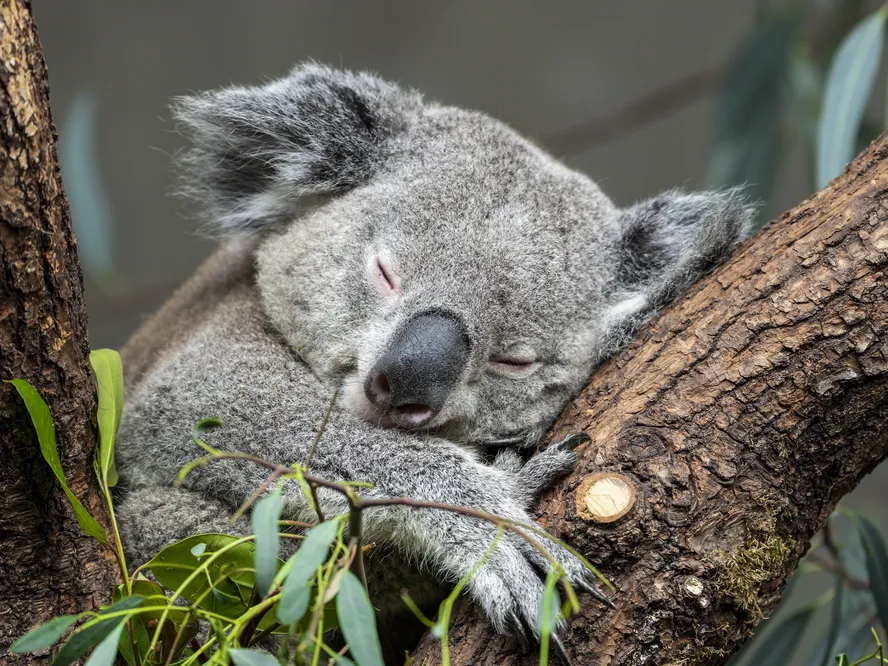The English Springer Spaniel named Max has become an unexpected figure in the field of environmental conservation, playing a vital and increasingly valued role in the fight to save koalas, one of the most iconic species of Australian wildlife. Max, a dog with exceptional sniffing abilities, was initially trained for hunting but eventually became a conservation hero by using his keen sense of smell to locate koala feces. This work is essential for gathering crucial data that helps scientists and ecologists in preserving this endangered species.
Koalas are known for their adorable appearance and calm behavior, but their population has faced an alarming decline in recent decades. In 2022, the Australian government classified koalas as an endangered species, particularly in the regions of the eastern coast of Australia, where most of the population resides. According to recent estimates, the koala population has halved in the past 20 years due to a series of threats, including habitat destruction, diseases, climate change, prolonged droughts, and devastating wildfires.

Max, despite his hunting dog origins, has shown remarkable talent for sniffing out koala feces, and this seemingly simple behavior has proven crucial to conservation efforts. When he locates the feces, Max lies down next to the find, gently touching it with his nose and waiting for approval from his trainer, Jack Nesbitt, so he can be rewarded with his favorite tennis ball. This simple yet crucial gesture triggers a series of actions that have significant impacts on research about the species.
The koala feces that Max locates are a valuable source of information for scientists. Analyzing these samples in specialized laboratories can reveal a range of data about the health of koalas. Among the most important findings is the presence of chlamydia, a disease affecting an increasing number of koalas, causing blindness, infertility, and premature death. Genetic analysis also provides crucial insights into how koalas are interacting with their environment, allowing researchers to track the movements of the animals, better understand their dispersal patterns, and identify isolated populations that need more protection.
“With Max’s help, we can identify individual koalas just by their feces. This allows us to better understand population dynamics and their interaction with the environment,” explains Jack Nesbitt, who founded the organization Canines for Wildlife, dedicated to training dogs for species conservation. Thanks to Max’s work, in 2024, a new group of koalas was identified in the Coffs Harbour region on the east coast of Australia. The most interesting aspect of this discovery was that these koalas were free from chlamydia, which represents hope for conservation efforts since a healthy population is more easily preserved and even expanded.
Despite the crucial work carried out by Max and other dogs from Canines for Wildlife, koalas face an existential threat that goes beyond disease detection. The greatest challenge for these animals remains the destruction of their habitat, largely caused by deforestation for agriculture, housing construction, mining, and timber extraction. A parliamentary investigation conducted in 2020 revealed that, without immediate government action, koalas could disappear entirely from some regions of Australia by 2050.
The government’s estimate that there are about 36,000 koalas in New South Wales has been questioned, with experts pointing out that this figure is “outdated and unreliable” due to the ongoing population decline.
Habitat loss is an especially serious issue for koalas, which are extremely selective about their diet. They survive almost exclusively on eucalyptus leaves, a plant that is toxic to most animals but that koalas have learned to digest over millions of years of evolution. When their feeding areas are destroyed, they are left without food sources, which can lead to malnutrition and death. Additionally, habitat destruction can isolate groups of koalas, making reproduction more difficult and putting them at greater risk.
Moreover, urbanization and the construction of roads, railways, and other infrastructure elements frequently isolate koala populations, making it harder for individuals to meet and reproduce. Many koalas are also victims of road accidents and attacks by domestic dogs, making habitat loss an even more devastating risk factor. Wildfires, exacerbated by climate change, represent another major threat. The 2019-2020 fire season was particularly tragic, with more than 5,000 koalas killed in New South Wales, an event that dramatically demonstrated the species’ vulnerability.
In response to these threats, the Australian government has committed millions of dollars to create a Koala National Park, which will cover an area of 315,000 hectares. This is an important measure to preserve the koalas’ natural habitat, but environmentalists warn that deforestation continues within the areas proposed for the park, undermining its objectives. Although the government has halted logging activities in some critical areas, the pressure to expand protection areas continues.
Canines for Wildlife does not engage directly in political campaigns, but its data is used by environmental advocacy groups to pressure the government to protect the most critical areas for koalas. “The work we do with the dogs has an immediate practical application. We can identify the areas of greatest importance for koala protection and provide this information to decision-makers,” says Nesbitt. In one of the regions where the organization is working, in Coffs Harbour, one of the largest koala population centers in New South Wales, data collected by the dogs is used to ensure that the most vital areas for the species’ survival are preserved.
Stuart Blanch, from WWF-Australia, comments that koala detection has significantly evolved in recent decades. Traditional methods, such as listening for the characteristic sounds of koalas or using flashlights to detect their glowing eyes at night, have been replaced by more advanced technologies such as drones and sniffer dogs. However, dogs still offer undeniable advantages. They can detect the presence of a koala even after it has moved and are able to sniff in dense vegetation areas where drones cannot access.
Canines for Wildlife is training dogs to work with other endangered species, such as the Hastings River mouse, and is currently in the process of training dogs to detect the rare and critically endangered Kroombit Tinker frog. “Dogs are not just hunting companions. They have become an essential tool for conservation,” says Nesbitt. “Their ability to detect things that humans cannot perceive with our senses makes them immensely valuable to ecologists.”
Max, like other dogs from his organization, may not seem like the kind of animal we would typically associate with conservation, but his ability to detect koala feces is helping ensure the species has a chance of survival. Max’s contribution, and that of other dogs like him, is a true revolution in the way we approach biodiversity preservation, reminding us that, often, conservation heroes come in unexpected forms.

